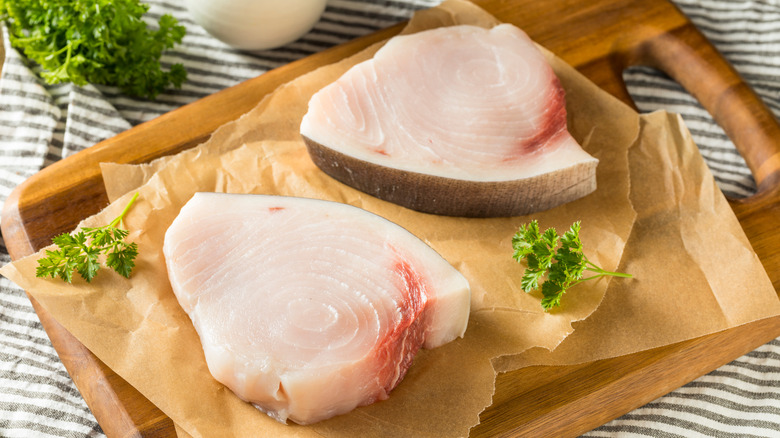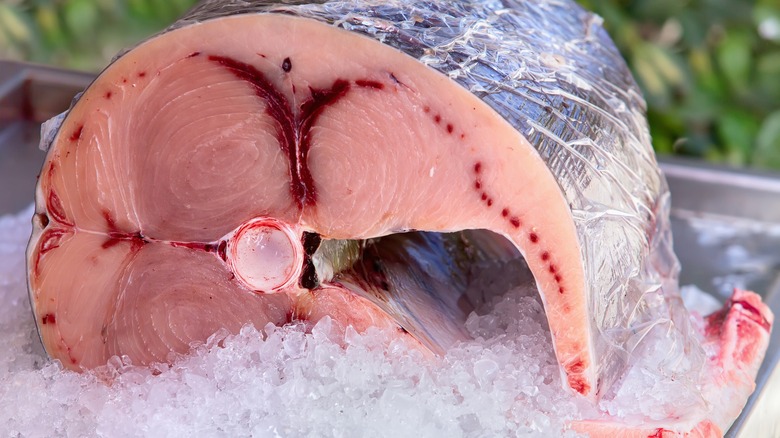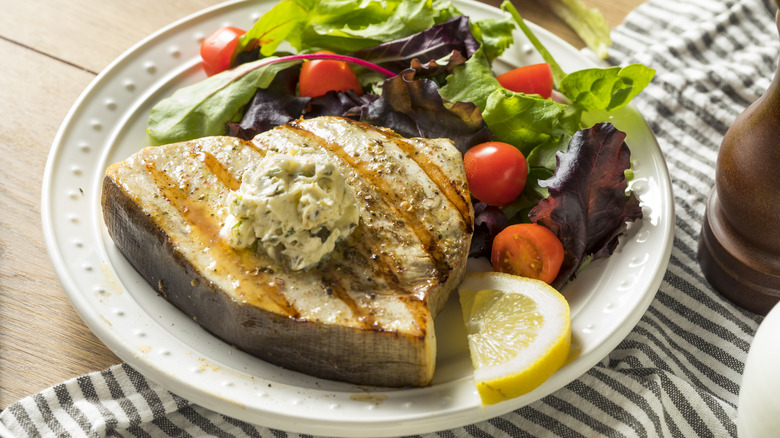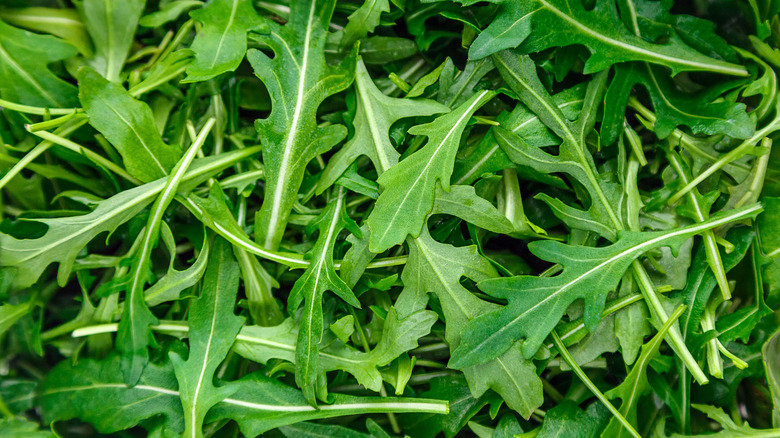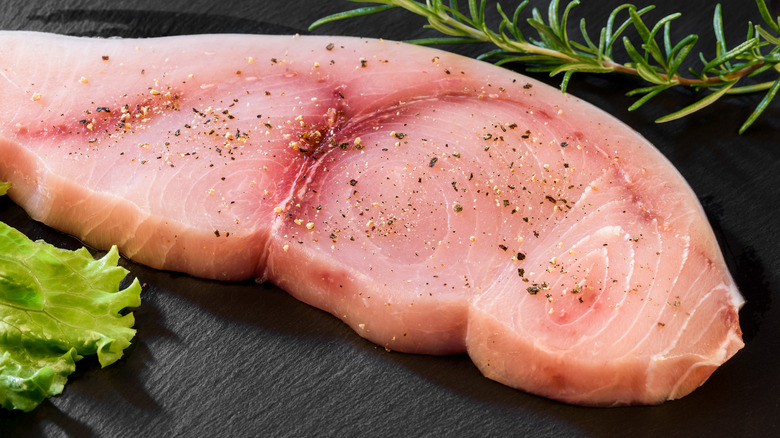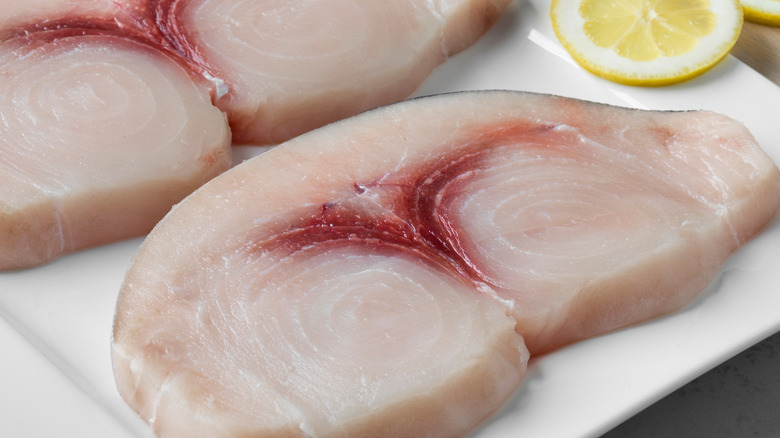A Beginner's Guide To Swordfish
Swordfish live in seas around the world and are eaten in a variety of countries. It's not difficult to find swordfish on sale in fish markets or supermarkets, especially near the coast, and it's certainly a meat worth trying. Unlike other oily fish, like salmon, it has quite a mild, slightly sweet flavor, while also being as dense and meaty as a good tuna steak. Swordfish also has a firm, moist texture when cooked, staying less flaky than other white fish.
The gentle flavor makes swordfish a good choice for those who don't usually like seafood, with less of a "fishy" flavor than other more common choices. The meat naturally varies a little in color, though, from pure white to a darker, reddish color, and the bands of darker meat tend to have a stronger flavor. This may be good or bad depending on personal tastes, so it's worth bearing this in mind when choosing which cut to bring home to your kitchen.
One of the big differences between swordfish and other types of fish though is that while many fish are available as fillets, swordfish are usually sold as steaks. These are just as thick and weighty as steaks of red meat like beef, and they're similar to cook. They may also come with skin attached, which should be trimmed off either before or after cooking. There are quite a few things to consider if you're planning on cooking swordfish at home.
Buying swordfish
You'll want to pick the best swordfish steak you can for your dinner table, and there are a few things to watch for. Swordfish meat should have a whorling circular pattern, which is quite easy to spot. The meat should be dense-looking, and any cut surfaces should look smooth and slick, with no dull or discolored skin. This is a good way to ensure the steaks you're looking at are fresh.
Some variation in meat color is perfectly normal; you may find steaks with darker, reddish bands which loosely follow the grain of the meat. These patches are fattier and tend to have a stronger flavor. Occasionally, you may also find orange swordfish steaks on sale: These are known as pumpkin swordfish, and the vibrant color is derived from fish that have a diet rich in shrimp. Orange swordfish steaks are considered a delicacy, and they often sell at higher prices.
However, there are things to be wary of, too. Some swordfish carry parasites in the form of large, visible worms. These aren't harmful to humans and can be carefully removed before cooking, but they can still look rather unappetizing. Be absolutely certain to avoid any cuts with soft-looking jellylike flesh, which is not fit for consumption; this is caused by a microscopic parasite that cannot be found until the meat is cut. Good fishmongers should, of course, check for these things before selling them, but it's still best to be aware of these possible issues.
How to store swordfish
Swordfish doesn't stay fresh for long! It only keeps in the refrigerator for one to two days, so it's best to buy it when you're planning to use it soon. Be careful not to leave it at room temperature for too long, as bacteria can grow rapidly on swordfish meat (and any other kind of fish, for that matter). It will spoil if left at room temperature for longer than two hours. If your journey home takes a long time, you may want to put your fish in a freezer bag to keep it cold instead of simply leaving it with your other groceries, just to be on the safe side.
Swordfish can be frozen at home too, which is very handy if your dinner plans suddenly change. Be certain to wrap it tightly to prevent freezer burn, which can wreck the taste and texture of any kind of meat. For this, you can use kitchen foil, freezer paper, plastic wrap, or a good-quality freezer bag. Be certain to date the wrapping, too, though, as swordfish will only keep for 2-3 months frozen. To defrost it, you can either leave it in the fridge overnight or hold it under running water.
Swordfish steaks
You'll nearly always see this meat on sale as swordfish steaks, which are perfect for grilling. For the simplest option, they can be very nicely prepared with a simple marinade and/or some light seasoning. A handy tip for grilling swordfish is also to brush it with some light oil, to make sure it doesn't stick during cooking. Alternatively, swordfish steaks are also great seared in a hot pan. For a finishing touch, chefs who like to use a blowtorch in the kitchen can use them very effectively on swordfish steaks, to crisp the edges without overcooking the meat; overcooked swordfish can otherwise become a little tough.
Swordfish can be cooked in a variety of styles, with a range of different seasonings, and it's usually prepared medium rare. That said, many chefs will advise serving it well cooked because of worries over bacteria or parasites. As with other types of meaty fish, though, this isn't a hard and fast rule and it all depends on the quality of the meat you're cooking.
Baked swordfish
Baking swordfish is a nice easy option, in addition to other methods such as grilling and pan frying. It should only take 15 to 20 minutes to bake properly, depending on the size of the steaks being used. Baked swordfish won't have any of the sharper taste of searing and can go very nicely with a creamy garlic sauce. Bolder herbs and spices can also nicely complement the mild taste of swordfish meat. Cayenne pepper and a pinch of cumin can give your dish a spicy kick, or you could give your swordfish an East Asian flavor with ginger, sesame oil, and a dash of soy sauce.
Mediterranean herbs like thyme, oregano, and particularly rosemary can also make for an aromatic dish. Finally, as with many different kinds of fish, a little lemon can complement the final flavor very nicely. It's best to use lemon zest rather than juice, though. This will help to avoid making the dish too sour, and it'll help avoid accidentally curdling any creamy sauce if you're using one.
Stewed and curried swordfish
Fish curry is a popular dish in Southeast Asia, but it can be a little tricky to make well. Many varieties of fish tend to fall apart into flakes when stewed for too long, often making fish soups a more common and easy option. Since swordfish is a denser kind of meat, it can work very well in a stew. A traditional Italian swordfish stew involves marinating chunks of meat overnight and then cooking them slowly over a gentle heat. The resulting swordfish is tender, with a rich-tasting broth.
Curried swordfish is also an excellent option. The dense but mild-tasting meat works well with milder, more aromatic spices. This makes it a good choice for Thai fish curry, so that the fragrant mixture of flavors and the slow burn of spice won't be overpowered by the taste of the meat. At the same time, you don't need to worry too much about adding the fish too soon, which often causes the fish to fall apart while cooking.
Swordfish kebabs
Kebabs are found in different areas of the world in numerous different kinds of variations, all mostly based on the concept of skewered and grilled meat and/or vegetables. Swordfish spiedini, for example, is an Italian take on kebabs. These skewers can use a variety of meats, together with vegetables and sometimes cheeses. Spiedini is traditionally made with red meats like beef or mutton, but swordfish is a firm enough meat to work perfectly. Swordfish is also great for making kebabs, as it's meaty enough to grill on skewers without risking it breaking apart and falling off.
There's plenty of room for variation with this kind of dish. Cutting your swordfish steak into cubes, about an inch in size, you can grill them on skewers together with your choice of vegetables or even halloumi cheese, also works very nicely for kebabs. To make the swordfish even more flavorsome, you can also try marinating it first. Swordfish kebabs like these can make an excellent food to cook and share at a barbecue in the summertime.
Uncooked swordfish
Uncooked fish dishes are eaten all around the world. They should, however, only be prepared with the highest possible quality fish to make sure they're safe to eat. Many people may avoid such dishes because of this due to worries about whether they're safe, but for those who enjoy uncooked fish dishes, many of these can work very nicely when prepared with swordfish. Fish intended for use in these dishes is sometimes treated before being sold by flash freezing, which sterilizes the meat without affecting the texture and overall quality.
For a Sicilian-style meal, swordfish carpaccio is made with finely sliced swordfish, carefully marinaded in lemon juice, and often artfully arranged. For a more Latin American flavor, swordfish ceviche is a tasty choice, made with thinly sliced or finely diced swordfish. The famous Hawaiian dish, poké, can also be made with swordfish for anyone who feels like a change from the usual ahi. Finally, Japanese sushi and sashimi are known for including a variety of types of fish, and swordfish is no exception. Known as mekajiki sashimi, swordfish prepared this way is a delicacy in Japan.
Side dishes for swordfish
Since swordfish is a mild-flavored meat, light-tasting side dishes complement it very well. Fresh-flavored vegetables like tomatoes or peppers are a good choice, with their bright flavors. A well-prepared coleslaw or salsa verde can also work nicely. Alternatively, richer and earthier flavors like mushrooms can also complement swordfish nicely, providing deeper notes of flavor without being overpowering.
Leafy vegetables can also pair very well with grilled swordfish. The crisp, juicy taste of bok choi, with its faintly mustardy taste, works quite well. Other options include a salad of mustard greens or a fresh, peppery arugula salad (sometimes known as rocket or roquette). One interesting vegetable which can go well with swordfish may be difficult to find outside Northern Europe. Samphire is a succulent vegetable that grows in coastal salt flats, with a mild, aromatic flavor. It's nicest when sautéed with a little butter, giving it a vibrant green color and a sweet, salty taste that pairs excellently with any kind of white fish, and swordfish is no exception.
Drinks pairings
When serving fish, the default option is a white wine, but swordfish is more robust than other types of white fish like cod or tilapia. Bolder wines can work very well paired with swordfish. A full-bodied white wine or even a medium-bodied red can pair nicely. Just avoid any reds with too much tannin, and it'll certainly taste great. Classic choices are Chardonnay or Rhône whites. Alternatively, some cocktails can go very well with a swordfish dish.
A refreshing, citrussy long cocktail made with lemon, lime, or grapefruit juice can be a great choice. If you're preparing a Mediterranean-style swordfish recipe, white sangria is another possibility. Of course, alcoholic drinks aren't the only option. There are plenty of non-alcoholic drinks with the crisp, astringent flavor of citrus, which will also taste great with a good swordfish meal. Homemade lemonade is a simple, delicious, and highly refreshing choice.
A sustainable seafood choice
Ethically sourced food is a growing concern for many people, and not without good reason. Many people are becoming increasingly conscious of the environmental impact of our dietary choices. The fishing industry has a rocky past. Reassuringly, according to NOAA Fisheries, swordfish is one of the most sustainable kinds of seafood available in North America.
In the 1990s, declining swordfish populations raised worries about overfishing, leading to careful management of wild-caught swordfish, both in the North Atlantic and Pacific. As an added bonus, swordfish is available all year round, meaning it's always an option for the dinner table. Of course, there may still be good reasons to be cautious. For those who are uncertain or living in other parts of the world without such careful regulations, some alternatives might be more attractive. There are fewer concerns surrounding overfishing for fish like Mahi mahi, which can be a good substitute for swordfish as it has the same taste, albeit without the same texture.
Make sure you're buying swordfish
One big concern in some parts of the world is to make certain that what you're buying is actually swordfish. According to The Guardian, there have been troubling cases of Mediterranean fishers catching sharks and passing them off as swordfish. Needless to say, this is illegal for various reasons, but it has happened nonetheless. This shark meat has then been sold as swordfish, bringing in a higher price than sharks usually would. In the worst cases, this has also resulted in the sale of endangered shark species. Mislabelled shark meat has been found sold in supermarkets and, in some cases, even in restaurants.
Shark meat can look very similar to swordfish at first glance, and those concerned may want to learn more about how to distinguish the two. Swordfish steaks should have an unmistakable pattern of concentric circles. Shark meat also tends to be softer, puffier, and more grainy. A commonly caught shark is the mako shark, which also doesn't tend to have the brownish bands of fatty meat often seen in Swordfish. The mako shark also has practically no scent when it's raw.
Swordfish and nutrition
Swordfish is a very nutritious type of fish. It's rich in potassium and magnesium, as well as being high in vitamin D, which people further from the equator may need more of during the darker winter months. Swordfish is also rich in selenium, a mineral that benefits a variety of things in your body, like metabolism, thyroid health, immunity, and heart health. Selenium has also been shown to have some anti-cancer properties. Since swordfish is so nutrient-rich, it can be a wonderful choice for anyone on a calorie-controlled diet as it helps ensure good nutrition even while eating less.
Swordfish is also considered an oily fish, like salmon, mackerel, and sardines, although, unlike other oily fish, it doesn't have the same strong taste and aroma. One thing it does have, however, is a high level of omega-3 oils. These have a range of health benefits, including preventing heart disease and helping to regulate diseases like lupus and rheumatoid arthritis. It's worth keeping in mind, though, that while swordfish is high in omega-3, salmon is still the richest source by far.
Mercury in swordfish
One health concern in long-lived predatory fish is mercury, a toxic metal that washes into the ocean and can slowly build up in a fish's body over time. The longer a fish lives, the more mercury it may contain. Swordfish, unfortunately, are just such a fish. In fact, swordfish can sometimes contain even higher levels of mercury than other fish like sharks or king mackerel. Some people choose not to eat swordfish as a result, particularly during pregnancy.
As a result, it's wise not to eat swordfish too often. The FDA recommends not eating swordfish more than once a week or more than once a month during pregnancy. This is to limit your exposure to any mercury which may be present in the meat. For those still concerned, are a few ways to help remove excess mercury (and other toxins) from your system. Drinking plenty of water and eating fiber-rich foods are two simple ways to help your body remove excess heavy metals like mercury from your body. Besides, it's important for your health to stay well hydrated.
Swordfish and religious diets
There's some disagreement in Muslim and Jewish communities about whether swordfish can be eaten as part of a religious diet. The rules of kosher food specifically say that only scaled fish should be eaten, so some Orthodox Jews consider swordfish non-kosher because of its lack of scales. It's not a clear-cut issue, though, as swordfish are scientifically considered scaled fish; swordfish do have scales when young, only losing them after they become adults. As a fish that formerly had scales, some Jews do consider swordfish kosher, provided it definitely is swordfish and not a different fish like a shark.
The debate is similar among Muslims, and some list swordfish alongside non-halal seafood like shark and eel. Again though, this isn't universally accepted. Many Muslims consider virtually all seafood to be halal, with the Qur'an essentially permitting anything caught from the sea, and this obviously includes swordfish. Seemingly though, the consensus varies with different communities and sects. The best way for Jews and Muslims to be certain is probably to ask their local Rabbi or Imam to make sure swordfish can be eaten as part of their diet.

